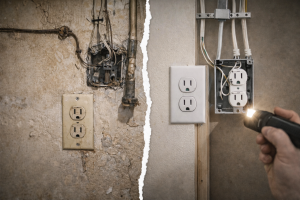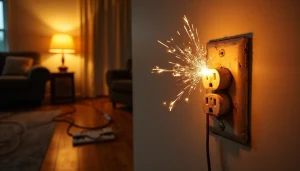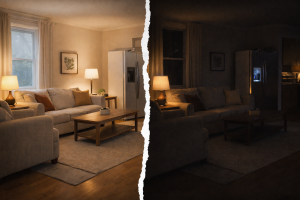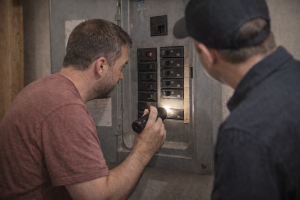Owning an older home comes with a certain charm—whether it’s the intricate woodwork, vintage aesthetics, or the sense of history within its walls. However, while older homes can be full of character, they often come with their own set of electrical challenges. Many homes built before modern building codes were put in place may not meet today’s safety and efficiency standards. Electrical issues in older homes can pose safety hazards and lead to costly repairs if left unchecked.
Key Takeaways
- Outdated Wiring can be a major safety hazard, and upgrading to modern wiring is crucial to avoid fire risks and support modern electrical demands.
- Overloaded Circuits are common in older homes and can lead to breaker trips or even fires. Upgrading the electrical panel can mitigate this.
- Insufficient Grounding is a dangerous problem in many older homes, and upgrading outlets to grounded, GFCI-protected options can greatly improve safety.
- Old Electrical Panels cannot handle the load of modern appliances. Upgrading to a more powerful panel improves both safety and efficiency.
- Lack of Adequate Lighting is common in older homes, and installing modern lighting fixtures can both improve safety and enhance your home’s aesthetic appeal.
1. Outdated Wiring: A Major Safety Hazard
One of the most common issues in older homes is outdated wiring. Homes built before the 1960s often use aluminum or knob-and-tube wiring, which is not only inefficient but can also be dangerous. Modern appliances and devices draw much more electricity than homes from previous generations were designed to handle. This can lead to overloaded circuits, increasing the risk of electrical fires.
How to Fix It:
If your home has outdated wiring, it’s essential to have a licensed electrician inspect the system. In many cases, a complete rewire may be necessary to bring the home up to code. Rewiring ensures that your electrical system can safely handle the demands of modern technology, reducing the risk of hazards.
2. Overloaded Circuits: The Silent Threat
Older homes often don’t have enough circuits to handle the electricity demands of today’s appliances, HVAC systems, and electronics. This can lead to overloaded circuits, which are a frequent cause of breaker trips and electrical fires. An overloaded circuit occurs when too much current flows through the wires, generating heat that can damage the insulation or even cause fires.
How to Fix It:
To prevent this from happening, homeowners should refrain from plugging too many high-wattage devices into a single outlet. Additionally, upgrading your electrical panel to handle more circuits may be necessary. An experienced electrician can perform a whole house circuit mapping to identify which circuits are at risk of being overloaded and offer appropriate solutions, such as adding new circuits or upgrading the panel.
3. Insufficient Grounding: A Modern Requirement
Grounding is an essential part of any electrical system because it provides a pathway for excess electricity to safely exit the system, reducing the risk of electrical shock. Unfortunately, many older homes were not built with proper grounding in place. Ungrounded outlets pose a significant danger, especially in rooms where water is present, such as kitchens and bathrooms.
How to Fix It:
Upgrading to grounded outlets is a must for older homes. In addition to grounding, you should also consider installing GFCI (Ground Fault Circuit Interrupter) outlets in areas where water and electricity might come into contact, such as near sinks, in garages, and outdoors. A qualified electrician can inspect your home’s wiring system and replace ungrounded outlets with safer, modern alternatives.
4. Inefficient or Old Electrical Panels
Electrical panels act as the central hub for your home’s electrical system. They distribute electricity to different circuits within the home. Older homes often have outdated electrical panels that are not capable of handling the power requirements of today’s modern appliances, heating systems, and entertainment setups. These older panels, often rated for 60 to 100 amps, are inadequate for modern needs, where 200 amps is often the standard.
How to Fix It:
If your electrical panel is outdated, upgrading to a modern panel with a higher capacity is essential. A panel upgrade will not only increase your home’s electrical capacity but also improve safety and efficiency. It’s also important to regularly check for warning signs such as flickering lights, frequent breaker trips, and a burning smell near the panel, as these can indicate that an upgrade is urgently needed.
5. Lack of Adequate Lighting
Older homes were often designed with fewer electrical outlets and limited lighting options. This can result in poorly lit spaces and an inconvenient number of outlets for today’s modern households, which rely on numerous electronic devices. Insufficient lighting can create dark, unsafe areas in homes, especially in hallways, staircases, and outdoor spaces.
How to Fix It:
An easy fix for outdated lighting systems is to have custom lighting installations done. Whether you want recessed lights for a sleek modern look, outdoor security lights for safety, or under-cabinet lighting in the kitchen, an experienced electrician can design and install lighting solutions that meet your needs. Upgrading your home’s lighting not only improves safety but also enhances the overall ambiance and functionality of your living spaces.
Frequently Asked Question
What are the signs that my home’s electrical system is outdated?
Look for frequent breaker trips, flickering lights, ungrounded outlets, and old-style wiring like knob-and-tube. These are signs that your system may need an upgrade.
Can I upgrade my home’s wiring by myself?
It’s strongly recommended that you hire a licensed electrician to handle any rewiring or electrical upgrades. Electrical work can be dangerous and is best left to professionals.
How much does it cost to rewire an older home?
The cost of rewiring a home depends on its size, the complexity of the job, and local labor rates. On average, it can range from $8,000 to $15,000, but it’s best to get a quote from an experienced electrician.
What is a GFCI outlet, and why do I need one?
A GFCI (Ground Fault Circuit Interrupter) outlet protects against electrical shock by cutting off power if it detects an imbalance in the electrical current. They are required in areas where water is present, such as kitchens, bathrooms, and outdoor spaces.
How often should I have my home’s electrical system inspected?
It’s a good idea to have your home’s electrical system inspected every 3 to 5 years, or immediately if you notice any warning signs of an electrical problem.
Trust Martin’s Electrical & Lighting Company for Your Electrical Solutions
Owning an older home comes with both rewards and responsibilities. While the charm and character are undeniable, ensuring that your home’s electrical system is safe and up to modern standards is essential. From outdated wiring to overloaded circuits, addressing these common issues can prevent costly repairs and keep your family safe.
If you’re experiencing any electrical issues in your home or you’re unsure whether your system meets current safety standards, Martin’s Electrical & Lighting Company is here to help. With over 25 years of experience serving Los Angeles, Orange County, and San Bernardino County, we specialize in updating electrical systems in older homes. Contact us today to schedule an inspection or get a free estimate on electrical repairs and upgrades. Let Martin’s Electrical & Lighting Company help you bring your home’s electrical system into the modern era while ensuring the highest standards of safety and efficiency!





